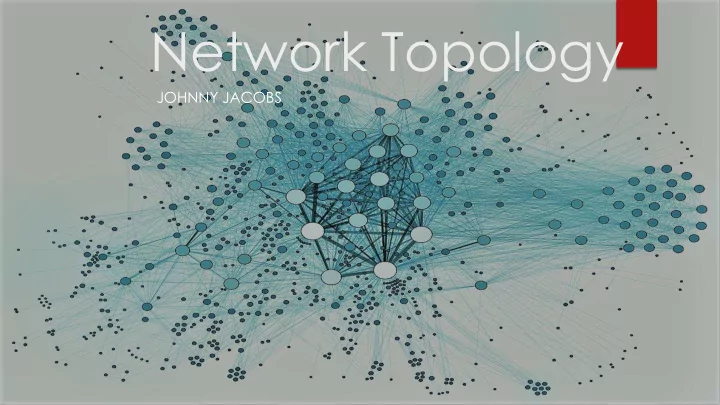

Network Topology JOHNNY JACOBS
Networks as Graphs Simplified abstraction Intuitive Nodes are hosts, routers, switches Edges are connections Allows simulation Convenient Cost effective
What is Topology? Generally Branch of mathematics concerned with geometric relation between points Computer Networks Physical topology Physical connections Logical (Network) topology Data flow
How is it useful? Network Management Reliability Identify points of failure Routing Throughput Root cause analysis Topology dependent algorithms Cycles Other insights
Base Protocols Broadcast Protocols STP(Spanning Tree Protocol) Routing Protocols RIP(Routing Information Protocol) OSPF(Open Shortest Path First) Management Protocols SNMP(Simple Network Management Protocol) ICMP(Internet Control Message Protocol)
Broadcast Protocols
STP
STP Builds a spanning tree All nodes connected Not redundant edges Not necessarily minimal Allows for efficient broadcast
Internet Routing Protocols
RIP
RIP Essentially distance vector Uses hop count (limit 15) Every link has cost 1 Share up to 25 destinations Share on change Share every 30 secs Neighbor dead if not heard in 180 sec
OSPF
OSPF Hierarchical Dijkstra's Broadcast link state Configurable link weight metric Ex. Hops, inverse capacity, etc. Authentication Multi-path Hello messages
Network Management Protocols
SNMP
SNMP Single manager, many agents Agents can be anything: routers, hosts, switches Operates mostly on MIB (management information base) information store, holds state of network Mostly requests for, or setting of, MIB
ICMP
ICMP Top-level diagnostic messages Ping requests/replies Traceroute TTL expiration and destination unreachable
Putting it together
Hybrid Algorithm Network Topology Uses routing tables from SNMP MIB information to identify routers and switches Physical Topology Probes subnets using OSPF and STP
Bibliography Textbook and slides http://ieeexplore.ieee.org/stamp/stamp.jsp?arnumber=6414020 Title image: commons.wikimedia.org Other images: http://www.electricmonk.org.uk http://www.bogotobogo.com
Recommend
More recommend